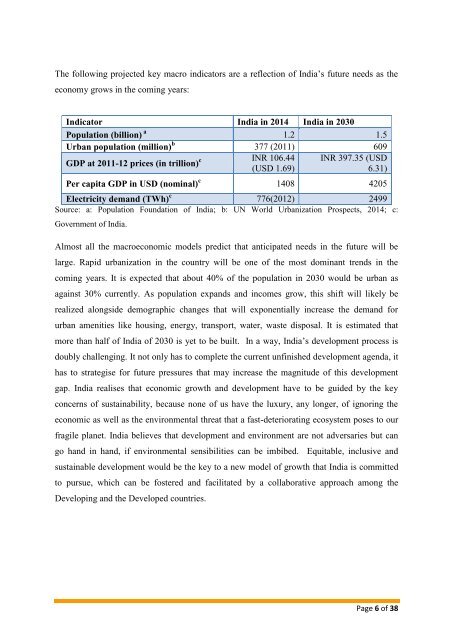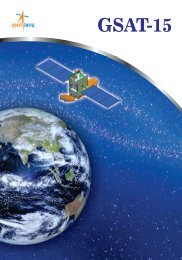INDIA’S INTENDED NATIONALLY DETERMINED CONTRIBUTION
1WsYDcS
1WsYDcS
Create successful ePaper yourself
Turn your PDF publications into a flip-book with our unique Google optimized e-Paper software.
The following projected key macro indicators are a reflection of India’s future needs as the<br />
economy grows in the coming years:<br />
Indicator India in 2014 India in 2030<br />
Population (billion) a 1.2 1.5<br />
Urban population (million) b 377 (2011) 609<br />
GDP at 2011-12 prices (in trillion) c INR 106.44<br />
(USD 1.69)<br />
INR 397.35 (USD<br />
6.31)<br />
Per capita GDP in USD (nominal) c 1408 4205<br />
Electricity demand (TWh) c 776(2012) 2499<br />
Source: a: Population Foundation of India; b: UN World Urbanization Prospects, 2014; c:<br />
Government of India.<br />
Almost all the macroeconomic models predict that anticipated needs in the future will be<br />
large. Rapid urbanization in the country will be one of the most dominant trends in the<br />
coming years. It is expected that about 40% of the population in 2030 would be urban as<br />
against 30% currently. As population expands and incomes grow, this shift will likely be<br />
realized alongside demographic changes that will exponentially increase the demand for<br />
urban amenities like housing, energy, transport, water, waste disposal. It is estimated that<br />
more than half of India of 2030 is yet to be built. In a way, India’s development process is<br />
doubly challenging. It not only has to complete the current unfinished development agenda, it<br />
has to strategise for future pressures that may increase the magnitude of this development<br />
gap. India realises that economic growth and development have to be guided by the key<br />
concerns of sustainability, because none of us have the luxury, any longer, of ignoring the<br />
economic as well as the environmental threat that a fast-deteriorating ecosystem poses to our<br />
fragile planet. India believes that development and environment are not adversaries but can<br />
go hand in hand, if environmental sensibilities can be imbibed. Equitable, inclusive and<br />
sustainable development would be the key to a new model of growth that India is committed<br />
to pursue, which can be fostered and facilitated by a collaborative approach among the<br />
Developing and the Developed countries.<br />
Page 6 of 38



